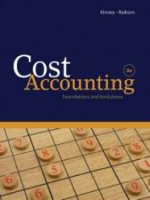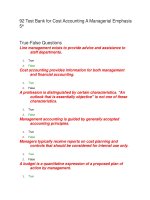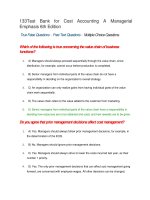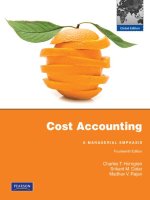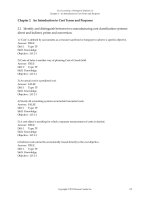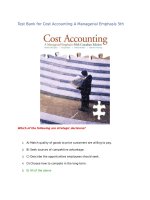Solution manual cost accounting a managerial emphasis 13e by horngren ch04
Bạn đang xem bản rút gọn của tài liệu. Xem và tải ngay bản đầy đủ của tài liệu tại đây (379.74 KB, 42 trang )
To download more slides, ebook, solutions and test bank, visit
CHAPTER 4
JOB COSTING
4-1
Cost pool––a grouping of individual cost items.
Cost tracing––the assigning of direct costs to the chosen cost object.
Cost allocation––the assigning of indirect costs to the chosen cost object.
Cost-allocation base––a factor that links in a systematic way an indirect cost or group of
indirect costs to a cost object.
4-2
In a job-costing system, costs are assigned to a distinct unit, batch, or lot of a product or
service. In a process-costing system, the cost of a product or service is obtained by using broad
averages to assign costs to masses of identical or similar units.
4-3
An advertising campaign for Pepsi is likely to be very specific to that individual client.
Job costing enables all the specific aspects of each job to be identified. In contrast, the
processing of checking account withdrawals is similar for many customers. Here, process costing
can be used to compute the cost of each checking account withdrawal.
4-4
The seven steps in job costing are: (1) identify the job that is the chosen cost object, (2)
identify the direct costs of the job, (3) select the cost-allocation bases to use for allocating
indirect costs to the job, (4) identify the indirect costs associated with each cost-allocation base,
(5) compute the rate per unit of each cost-allocation base used to allocate indirect costs to the job,
(6) compute the indirect costs allocated to the job, and (7) compute the total cost of the job by
adding all direct and indirect costs assigned to the job.
4-5
Two major cost objects that managers focus on in companies using job costing are (1)
products or jobs, and (2) responsibility centers or departments.
4-6
Three major source documents used in job-costing systems are (1) job cost record or job
cost sheet, a document that records and accumulates all costs assigned to a specific job, starting
when work begins (2) materials requisition record, a document that contains information about
the cost of direct materials used on a specific job and in a specific department; and (3) labor-time
record, a document that contains information about the labor time used on a specific job and in a
specific department.
4-7
The main concern with the source documents of job cost records is the accuracy of the
records. Problems occurring in this area include incorrect recording of quantity or dollar amounts,
materials recorded on one job being “borrowed” and used on other jobs, and erroneous job
numbers being assigned to materials or labor inputs.
4-8
a.
b.
Two reasons for using an annual budget period are
The numerator reason––the longer the time period, the less the influence of seasonal
patterns, and
The denominator reason––the longer the time period, the less the effect of variations in
output levels on the allocation of fixed costs.
4-1
To download more slides, ebook, solutions and test bank, visit
4-9
Actual costing and normal costing differ in their use of actual or budgeted indirect cost
rates:
Actual
Normal
Costing
Costing
Direct-cost rates
Actual rates
Actual rates
Indirect-cost rates
Actual rates
Budgeted rates
Each costing method uses the actual quantity of the direct-cost input and the actual quantity of
the cost-allocation base.
4-10 A house construction firm can use job cost information (a) to determine the profitability
of individual jobs, (b) to assist in bidding on future jobs, and (c) to evaluate professionals who
are in charge of managing individual jobs.
4-11 The statement is false. In a normal costing system, the Manufacturing Overhead Control
account will not, in general, equal the amounts in the Manufacturing Overhead Allocated
account. The Manufacturing Overhead Control account aggregates the actual overhead costs
incurred while Manufacturing Overhead Allocated allocates overhead costs to jobs on the basis
of a budgeted rate times the actual quantity of the cost-allocation base.
Underallocation or overallocation of indirect (overhead) costs can arise because of (a) the
Numerator reason––the actual overhead costs differ from the budgeted overhead costs, and (b)
the Denominator reason––the actual quantity used of the allocation base differs from the
budgeted quantity.
4-12 Debit entries to Work-in-Process Control represent increases in work in process.
Examples of debit entries under normal costing are (a) direct materials used (credit to Materials
Control), (b) direct manufacturing labor billed to job (credit to Wages Payable Control), and (c)
manufacturing overhead allocated to job (credit to Manufacturing Overhead Allocated).
4-13 Alternative ways to make end-of-period adjustments for underallocated or overallocated
overhead are as follows:
(i) Proration based on the total amount of indirect costs allocated (before proration) in
the ending balances of work in process, finished goods, and cost of goods sold.
(ii) Proration based on total ending balances (before proration) in work in process,
finished goods, and cost of goods sold.
(iii) Year-end write-off to Cost of Goods Sold.
(iv) Restatement of all overhead entries using actual indirect cost rates rather than
budgeted indirect cost rates.
4-14 A company might use budgeted costs rather than actual costs to compute direct labor
rates because it may be difficult to trace direct labor costs to jobs as they are completed (for
example, because bonuses are only known at the end of the year).
4-15 Modern technology such as electronic data interchange (EDI) is helpful to managers
because it provides them with quick and accurate product-cost information that facilitates the
management and control of jobs.
4-2
To download more slides, ebook, solutions and test bank, visit
4-16
a.
b.
c.
d.
e.
f.
g.
h.
i.
j.
k.
Job costing
Process costing
Job costing
Process costing
Job costing
Process costing
Job costing
Job costing (but some process costing)
Process costing
Process costing
Job costing
4-17
1.
(10 min) Job order costing, process costing.
l.
m.
n.
o.
p.
q.
r.
s.
t.
u.
Job costing
Process costing
Job costing
Job costing
Job costing
Job costing
Process costing
Job costing
Process costing
Job costing
(20 min.) Actual costing, normal costing, accounting for manufacturing overhead.
Budgeted manufacturing
overhead rate
Actual manufacturing
overhead rate
=
Budgeted manufacturing
overhead costs
Budgeted direct manufacturing
labor costs
=
$2, 700, 000
= 1.80 or 185%
$1,500, 000
=
Actual manufacturing
overhead costs
Actual direct manufacturing
labor costs
$2, 755, 000
= 1.9 or 190%
$1, 450, 000
Costs of Job 626 under actual and normal costing follow:
=
2.
Direct materials
Direct manufacturing labor costs
Manufacturing overhead costs
$30,000 1.90; $30,000 1.80
Total manufacturing costs of Job 626
4-3
Actual
Costing
Normal
Costing
$ 40,000
30,000
$ 40,000
30,000
57,000
$127,000
54,000
$124,000
To download more slides, ebook, solutions and test bank, visit
3.
Total manufacturing overhead
allocated under normal costing =
Actual manufacturing Budgeted
labor costs
overhead rate
= $1,450,000 1.80
= $2,610,000
Underallocated manufacturing =
overhead
Actual manufacturing – Manufacturing
overhead costs
overhead allocated
= $2,755,000 $2,610,000 = $145,000
There is no under- or overallocated overhead under actual costing because overhead is
allocated under actual costing by multiplying actual manufacturing labor costs and the actual
manufacturing overhead rate. This, of course equals the actual manufacturing overhead costs. All
actual overhead costs are allocated to products. Hence, there is no under- or overallocatead
overhead.
4-18
1.
(20 -30 min.) Job costing, normal and actual costing.
Budgeted indirectcost rate
=
Budgeted indirect costs
$8,000,000
=
Budgeted direct labor-hours 160,000 hours
= $50 per direct labor-hour
Actual indirectcost rate
=
Actual indirect costs
$6,888,000
=
Actual direct labor-hours
164,000 hours
= $42 per direct labor-hour
These rates differ because both the numerator and the denominator in the two calculations are
different—one based on budgeted numbers and the other based on actual numbers.
2a.
Normal costing
Direct costs
Direct materials
Direct labor
Indirect costs
Assembly support ($50 900; $50 1,010)
Total costs
4-4
Laguna
Model
Mission
Model
$106,450
36,276
142,726
$127,604
41,410
169,014
45,000
$187,726
50,500
$219,514
To download more slides, ebook, solutions and test bank, visit
2b.
Actual costing
Direct costs
Direct materials
Direct labor
Indirect costs
Assembly support ($42 900; $42 1,010)
Total costs
$106,450
36,276
142,726
$127,604
41,410
169,014
37,800
$180,526
42,420
$211,434
3.
Normal costing enables Anderson to report a job cost as soon as the job is completed,
assuming that both the direct materials and direct labor costs are known at the time of use. Once
the 900 direct labor-hours are known for the Laguna Model (June 2007), Anderson can compute
the $187,726 cost figure using normal costing. Anderson can use this information to manage the
costs of the Laguna Model job as well as to bid on similar jobs later in the year. In contrast,
Anderson has to wait until the December 2007 year-end to compute the $180,526 cost of the
Laguna Model using actual costing.
Although not required, the following overview diagram summarizes Anderson
Construction’s job-costing system.
INDIRECT
COST
POOL
Assembly
Support
COST
ALLOCATION
BASE
Direct
Labor-Hours
COST OBJECT:
RESIDENTIAL
HOME
Indirect Costs
DIRECT
COSTS
Direct Costs
Direct
Materials
4-5
Direct
Manufacturing
Labor
To download more slides, ebook, solutions and test bank, visit
4-19
(10 min.) Budgeted manufacturing overhead rate, allocated manufacturing overhead.
1.
Budgeted manufacturing overhead rate =
=
2.
Budgeted manufacturing overhead
Budgeted machine hours
$4, 000, 000
= $20 per machine-hour
200, 000 machine-hours
Manufacturing overhead allocated = Actual machine-hours ? Budgeted manufacturing overhead rate
= 195,000 × $20 = $3,900,000
3.
Since manufacturing overhead allocated is greater than the actual manufacturing overhead
costs, Waheed overallocated manufacturing overhead:
Manufacturing overhead allocated
Actual manufacturing overhead costs
Overallocated manufacturing overhead
4-6
$3,900,000
3,860,000
$ 40,000
To download more slides, ebook, solutions and test bank, visit
4-20
(20-30 min.) Job costing, accounting for manufacturing overhead, budgeted rates.
1.
An overview of the product costing system is
INDIRECT
COST
POOL
COST
ALLOCATION
BASE
Machining Department
Manufacturing Overhead
Assembly Department
Manufacturing Overhead
Machine-Hours
Indirect Costs
COST OBJECT:
PRODUCT
DIRECT
COST
Direct Manuf.
Labor Cost
Direct Costs
Direct
Materials
Direct
Manufacturing
Labor
Budgeted manufacturing overhead divided by allocation base:
Machining overhead
Assembly overhead:
2.
$1,800,000
= $36 per machine-hour
50,000
$3,600,000
= 180% of direct manuf. labor costs
$2,000,000
Machining department, 2,000 hours $36
Assembly department, 180% $15,000
Total manufacturing overhead allocated to Job 494
3.
Actual manufacturing overhead
Manufacturing overhead allocated,
55,000 $36
180% $2,200,000
Underallocated (Overallocated)
4-7
$72,000
27,000
$99,000
Machining
$2,100,000
Assembly
$ 3,700,000
1,980,000
—
$ 120,000
—
3,960,000
$ (260,000)
To download more slides, ebook, solutions and test bank, visit
4-21
(2025 min.) Job costing, consulting firm.
1.
Budgeted indirect-cost rate = $13,000,000 ÷ $5,000,000 = 260% of professional labor costs
2.
INDIRECT
COST
POOL
Client
Consulting
Consulting
Support
Support
COST
ALLOCATION
BASE
Professional
Professional
Labor
LaborCosts
Costs
COST OBJECT:
JOB FOR
CONSULTING
CLIENT
DIRECT
COSTS
Indirect Costs
Direct Costs
Professional
Labor
At the budgeted revenues of $20,000,000, Taylor’s operating income of $2,000,000
equals 10% of revenues.
Markup rate = $20,000,000 ÷ $5,000,000 = 400% of direct professional labor costs
4-8
To download more slides, ebook, solutions and test bank, visit
3.
Budgeted costs
Direct costs:
Director, $200 3
$ 600
Partner, $100 16
1,600
Associate, $50 40
2,000
Assistant, $30 160
4,800
Indirect costs:
Consulting support, 260% $9,000
Total costs
$ 9,000
23,400
$32,400
As calculated in requirement 2, the bid price to earn a 10% income-to-revenue margin is 400%
of direct professional costs. Therefore, Taylor should bid 4 $9,000 = $36,000 for the Red
Rooster job.
Bid price to earn target operating income-to-revenue margin of 10% can also be
calculated as follows:
or,
Let R = revenue to earn target income
R – 0.10R = $32,400
0.90R = $32,400
R = $32,400 ÷ 0.90 = $36,000
Direct costs
$ 9,000
Indirect costs
23,400
Operating income
3,600
Bid price
$36,000
4-9
To download more slides, ebook, solutions and test bank, visit
4-22
(15–20 min.) Service industry, time period used to compute indirect cost rates.
1.
Direct labor costs
Variable overhead costs as
a percentage of direct
labor costs
Variable overhead costs
(Percentage direct
labor costs)
Fixed overhead costs
Total overhead costs
Total overhead costs as a
percentage of direct labor
costs
Jan–March
Jan–
$400,000
April–June
April–
$280,000
90%
60%
$360,000
300,000
$660,000
165%
Job 332
Direct materials
Direct labor costs
Overhead allocated (variable + fixed)
(165%; 180%; 170% of $6,000)
Full cost of Job 332
July–Sept
July–
$250,000
60%
$168,000
300,000
$468,000
$150,000
300,000
$450,000
167%
180%
Oct––Dec
Oct
$270,000
Total
$1,200,000
60%
$162,000
300,000
$462,000
$ 840,000
1,200,000
$2,040,000
171%
170%
Budgeted Overhead Rate Used
Jan––March
Jan
July––Sept
July
Average
Rate
Rate
Yearly Rate
$10,000
$10,000
$10,000
6,000
6,000
6,000
9,900
$25,900
10,800
$26,800
10,200
$26,200
(a)
The full cost of Job 332, using the budgeted overhead rate of 165% for January–March, is
$25,900.
(b)
The full cost of Job 332, using the budgeted overhead rate of 180% for July–September,
is $26,800.
(c)
The full cost of Job 332, using the annual budgeted overhead rate of 170%, is $26,200.
2.
Budgeted fixed overhead rate based on annual fixed overhead costs and annual
direct labor costs = $1,200,000 $1,200,000 = 100%
Job 332
Direct materials
Direct labor costs
Variable overhead allocated
(90%; 60%; of $6,000)
Fixed overhead allocated
(100% of $6,000)
Full cost of Job 332
Budgeted Variable Overhead Rate Used
January––March
January
July––Sept
July
rate
rate
$10,000
$10,000
6,000
6,000
4-10
5,400
3,600
6,000
$27,400
6,000
$25,600
To download more slides, ebook, solutions and test bank, visit
(a)
The full cost of Job 332, using the budgeted variable overhead rate of 90% for
January–March and an annual fixed overhead rate of 100%, is $27,400.
(b)
The full cost of Job 332, using the budgeted variable overhead rate of 60% for
July–September and an annual fixed overhead rate of 100%, is $25,600.
3.
If Printers, Inc. sets prices at a markup of costs, then prices based on costs calculated as
in Requirement 2 (rather than as in Requirement 1) would be more effective in deterring clients
from sending in last-minute, congestion-causing orders in the January–March time frame. In this
calculation, more variable manufacturing overhead costs are allocated to jobs in the first quarter,
reflecting the larger costs of that quarter caused by higher overtime and facility and machine
maintenance. This method better captures the cost of congestion during the first quarter.
4-23
1.
(10–15 min.) Accounting for manufacturing overhead.
Budgeted manufacturing overhead rate =
$7,500, 000
250,000
= $30 per machine-hour
2.
Work-in-Process Control
7,350,000
Manufacturing Overhead Allocated
7,350,000
(245,000 machine-hours $30 per machine-hour = $7,350,000)
3.
$7,350,000– $7,300,000 = $50,000 overallocated, an insignificant amount of actual
manufacturing overhead costs $50,000 ÷ $7,300,000 = 0.66%.
Manufacturing Overhead Allocated
7,350,000
Manufacturing Department Overhead Control
Cost of Goods Sold
4-11
7,300,000
50,000
To download more slides, ebook, solutions and test bank, visit
4-24
(3545 min.) Job costing, journal entries.
Some instructors may also want to assign Exercise 4-25. It demonstrates the relationships of the
general ledger to the underlying subsidiary ledgers and source documents.
1.
An overview of the product costing system is:
INDIRECT
COST
POOL
COST
ALLOCATION
BASE
Manufacturing Overhead
Direct Manufacturing
Labor Costs
Indirect Costs
COST OBJECT:
PRINT JOB
DIRECT
COST
Direct Costs
Direct
Materials
4-12
Direct
Manuf.
Labor
To download more slides, ebook, solutions and test bank, visit
2. & 3.
This answer assumes COGS given of $4,020 does not include the writeoff of overallocated
manufacturing overhead.
2.
(1) Materials Control
Accounts Payable Control
(2) Work-in-Process Control
Materials Control
(3) Manufacturing Overhead Control
Materials Control
(4) Work-in-Process Control
Manufacturing Overhead Control
Wages Payable Control
(5) Manufacturing Overhead Control
Accumulated Depreciation––buildings and
manufacturing equipment
(6) Manufacturing Overhead Control
Miscellaneous accounts
(7) Work-in-Process Control
Manufacturing Overhead Allocated
(1.60 $1,300 = $2,080)
(8) Finished Goods Control
Work-in-Process Control
(9) Accounts Receivable Control (or Cash)
Revenues
(10) Cost of Goods Sold
Finished Goods Control
(11) Manufacturing Overhead Allocated
Manufacturing Overhead Control
Cost of Goods Sold
4-13
800
800
710
710
100
100
1,300
900
2,200
400
400
550
550
2,080
2,080
4,120
4,120
8,000
8,000
4,020
4,020
2,080
1,950
130
To download more slides, ebook, solutions and test bank, visit
3.
Bal. 12/31/2008
(1) Purchases
Bal. 12/31/2009
Bal. 12/31/2008
(2) Direct materials
(4) Direct manuf. labor
(7) Manuf. overhead
allocated
Bal. 12/31/2009
100
800
90
Materials Control
(2) Issues
(3) Issues
Work-in-Process Control
60
(8)Goods completed
710
1,300
Finished Goods Control
500
(10) Goods sold
4,120
600
(10) Goods sold
4,020
Bal. 12/31/2009
3,890
Indirect materials
Indirect manuf. labor
Depreciation
Miscellaneous
(11) To close
4,120
2,080
30
Bal. 12/31/2008
(8) Goods completed
Bal. 12/31/2009
(3)
(4)
(5)
(6)
Bal.
710
100
Cost of Goods Sold
(11) Adjust for overallocation
Manufacturing Overhead Control
100
(11) To close
900
400
550
0
Manufacturing Overhead Allocated
2,080
(7) Manuf. overhead allocated
Bal.
4-14
4,020
130
1,950
2,080
0
To download more slides, ebook, solutions and test bank, visit
4-25 (35 minutes) Journal entries, T-accounts, and source documents
documents.
1.
i. Direct Materials Control
124,000
Accounts Payable Control
124,000
Source Document: Purchase Invoice, Receiving Report
Subsidiary Ledger: Direct Materials Record, Accounts Payable
ii. Work in Process Control a
122,000
Direct Materials Control
122,000
Source Document: Material Requisition Records, Job Cost Record
Subsidiary Ledger: Direct Materials Record, Work-in-Process Inventory, Records by Jobs
iii. Work in Process Control
80,000
Manufacturing Overhead Control
54,500
Wages Payable Control
134,500
Source Document: Labor Time Records, Job Cost Records
Subsidiary Ledger:, Manufacturing Overhead Records, Employee Labor Records, Work-inProcess Inventory Records by Jobs
iv. Manufacturing Overhead Control
129,500
Salaries Payable Control
20,000
Accounts Payable Control
9,500
Accumulated Depreciation Control
30,000
Rent Payable Control
70,000
Source Document: Depreciation Schedule, Rent Schedule, Maintenance wages due, Invoices
for miscellaneous factory overhead items
Subsidiary Ledger: Manufacturing Overhead Records
v. Work in Process Control
200,000
Manufacturing Overhead Allocated
($80,000 $2.50)
Source Document: Labor Time Records, Job Cost Record
Subsidiary Ledger: Work-in-Process Inventory Records by Jobs
200,000
vi. Finished Goods Control b
387,000
Work in Process Control
387,000
Source Document: Job Cost Record, Completed Job Cost Record
Subsidiary Ledger: Work-in-Process Inventory Records by Jobs, Finished Goods Inventory
Records by Jobs
vii. Cost of Goods Sold c
432,000
Finished Goods Control
Source Document: Sales Invoice, Completed Job Cost Record
Subsidiary Ledger: Finished Goods Inventory Records by Jobs
viii.
Manufacturing Overhead Allocated
Manufacturing Overhead Control
Cost of Goods Sold
4-15
432,000
200,000
184,000
16,000
To download more slides, ebook, solutions and test bank, visit
Source Document: Prior Journal Entries
ix. Administrative Expenses
7,000
Marketing Expenses
120,000
Salaries Payable Control
30,000
Accounts Payable Control
90,000
Accumulated Depreciation, Office Equipment
7,000
Source Document: Depreciation Schedule, Marketing Payroll Request, Invoice for
Advertising, Sales Commission Schedule.
Subsidiary Ledger: Employee Salary Records, Administration Cost Records, Marketing Cost
Records.
a Materials used = Beginning direct materials inventory + Purchases Ending direct materials inventory
= $9,000 + $124,000 $11,000 = $122,000
b Cost of goods manufactured = Beginning WIP inventory + Manufacturing cost Ending WIP inventory
= $6,000 + ($122,000 + $80,000 + $200,000) $21,000
= 387,000
c Cost of Goods Sold = Beginning fin. goods inventory + Cost of goods manuf. Ending fin. goods inventory
= $69,000 + $387,0000 $24,000 = $432,000
4-16
To download more slides, ebook, solutions and test bank, visit
2.
T-accounts
Direct Materials Control
9,000
(2) Materials used
124,000
11,000
Bal. 1/1/2008
(1) Purchases
Bal. 12/31/2008
122,000 Issues
Work-in-Process Control
Bal. 1/1/2008
6,000
(6) Cost of goods manufactured 387,000
(2) Direct materials used 122,000
(3) Direct manuf. labor
80,000
(5) Manuf. overhead
allocated
200,000
Bal. 12/31/2008
21,000
Bal. 1/1/2008
(6) Cost of goods manuf.
Bal. 12/31/2008
Finished Goods Control
69,000
(7) Cost of goods sold
387,000
24,000
(7)
Cost of Goods Sold
432,000
(8) Adjust for overallocation
Goods sold
(3)Indirect labor
(4) Supplies
(4) Miscellaneous
(4 Depreciation
(4) Rent
Bal.
(8) To close
Manufacturing Overhead Control
54,500
(8) To close
20,000
9,500
30,000
70,000
0
Manufacturing Overhead Allocated
200,000
(5) Manuf. overhead allocated
Bal.
4-17
432,000
16,000
184,000
200,000
0
To download more slides, ebook, solutions and test bank, visit
4-26
(45 min.) Job costing, journal entries.
Some instructors may wish to assign Problem 4-24. It demonstrates the relationships of journal
entries, general ledger, subsidiary ledgers, and source documents.
1.
2.
(1)
(2)
(3)
(4)
(5)
(6)
(7)
(8)
(9)
(10a)
(10b)
An overview of the product-costing system is
INDIRECT
COST
POOL
Manufacturing
Overhead
COST
ALLOCATION
BASE
Machine-Hours
COST OBJECT
PRODUCT
DIRECT
COSTS
Indirect Costs
Direct Costs
Direct
Materials
Direct
Manuf. Labor
Amounts in millions.
Materials Control
Accounts Payable Control
Work-in-Process Control
Materials Control
Manufacturing Department Overhead Control
Materials Control
Work-in-Process Control
Wages Payable Control
Manufacturing Department Overhead Control
Wages Payable Control
Manufacturing Department Overhead Control
Accumulated Depreciation
Manufacturing Department Overhead Control
Various liabilities
Work-in-Process Control
Manufacturing Overhead Allocated
Finished Goods Control
Work-in-Process Control
Cost of Goods Sold
Finished Goods Control
Accounts Receivable Control (or Cash )
Revenues
4-18
150
150
145
145
10
10
90
90
30
30
19
19
9
9
63
63
294
294
292
292
400
400
To download more slides, ebook, solutions and test bank, visit
The posting of entries to T-accounts is as follows:
Bal.
(1)
Materials Control
12 (2)
150 (3)
Bal.
(9)
Finished Goods Control
6 (10a)
294
(3)
(5)
(6)
(7)
Manufacturing Department
Overhead Control
10 (11)
30
19
9
(10b)
145
10
Bal.
(2)
(4)
(8)
Bal.
Work-in-Process Control
2 (9)
145
90
63
6
292
(10a)
(11)
Cost of Goods Sold
292
5
Manufacturing Overhead Allocated
(11)
63 (8)
63
68
Accounts Payable Control
(1)
150
Accumulated Depreciation
(6)
19
Accounts Receivable Control
400
Wages Payable Control
(4)
(5)
90
30
Various Liabilities
(7)
9
Revenues
(10b)
400
The ending balance of Work-in-Process Control is $6.
3.
294
(11) Manufacturing Overhead Allocated
Cost of Goods Sold
Manufacturing Department Overhead Control
Entry posted to T-accounts in Requirement 2.
4-19
63
5
68
To download more slides, ebook, solutions and test bank, visit
4-27
(15 min.) Job costing, unit cost, ending work in progress.
1.
Direct manufacturing labor rate per hour
Manufacturing overhead cost allocated
per manufacturing labor-hour
$25
Direct manufacturing labor costs
Direct manufacturing labor hours
($275,000 $25; $200,000 $25)
Manufacturing overhead cost allocated
(11,000 $20; 8,000 $20)
Job Costs May 2009
Direct materials
Direct manufacturing labor
Manufacturing overhead allocated
Total costs
2.
Number of pipes produced for Job M1
Cost per pipe ($570,000 1,500)
$20
Job M1
$275,000
Job M2
$200,000
11,000
8,000
$220,000
$160,000
Job M1
$ 75,000
275,000
220,000
$570,000
Job M2
$ 50,000
200,000
160,000
$410,000
1,500
$380
3.
Finished Goods Control
Work-in-Process Control
570,000
570,000
4. Raymond Company began May 2009 with no work-in-process inventory. During May, it
started and finished M1. It also started M2, which is still in work-in-process inventory at the end
of May. M2’s manufacturing costs up to this point, $410,000, remain as a debit balance in the
Work-in-Process Inventory account at the end of May 2009.
4-20
To download more slides, ebook, solutions and test bank, visit
4-28
1.
(2030 min.) Job costing; actual, normal, and variation from normal costing.
Actual direct cost rate for professional labor = $58 per professional labor-hour
Actual indirect cost rate
=
$744,000
15,500 hours
= $48 per professional labor-hour
Budgeted direct cost rate
for professional labor
=
$960,000
16,000 hours
= $60 per professional labor-hour
Budgeted indirect cost rate =
$720,000
16,000 hours
= $45 per professional labor-hour
Direct-Cost Rate
Indirect-Cost Rate
2.
Direct Costs
Indirect Costs
Total Job Costs
(a)
(b)
Actual
Normal
Costing
Costing
$58
$58
(Actual rate)
(Actual rate)
$48
$45
(Actual rate) (Budgeted rate)
(c)
Variation of
Normal Costing
$60
(Budgeted rate)
$45
(Budgeted rate)
(b)
(a)
(c)
Actual
Normal
Variation of
Costing
Costing
Normal Costing
$58 120 = $ 6,960 $58 120 = $ 6,960 $60 120 = $ 7,200
48 120 = 5,760 45 120 = 5,400 45 120 = 5,400
$12,720
$12,360
$12,600
All three costing systems use the actual professional labor time of 120 hours. The budgeted 110
hours for the Pierre Enterprises audit job is not used in job costing. However, Chirac may have
used the 110 hour number in bidding for the audit.
The actual costing figure of $12,720 exceeds the normal costing figure of $12,360
because the actual indirect-cost rate ($48) exceeds the budgeted indirect-cost rate ($45). The
normal costing figure of $12,360 is less than the variation of normal costing (based on budgeted
rates for direct costs) figure of $12,600, because the actual direct-cost rate ($58) is less than the
budgeted direct-cost rate ($60).
4-21
To download more slides, ebook, solutions and test bank, visit
Although not required, the following overview diagram summarizes Chirac’s job-costing
system.
INDIRECT
COST
POOL
COST
ALLOCATION
BASE
Audit
Support
Professional
Labor-Hours
COST OBJECT:
JOB FOR
AUDITING
PIERRE
& CO.
Indirect Costs
Direct Costs
DIRECT
COST
Professional
Labor
4-22
To download more slides, ebook, solutions and test bank, visit
4-29 (30 min.) Job order costing: actual, normal, and variation from normal costing.
1a. Actual costing
Direct cost rate = Actual professional labor costs ÷ Actual professional labor-hours
= $1,320,000 ÷ 22,000 hours
= $60 per professional-hour
Indirect cost rate = Actual support costs ÷ Actual professional labor-hours
= $2,400,000 ÷ 22,000 hours
= $109.09 per professional-hour
1b. Normal costing
Budgeted professional hours = Budgeted hours per lawyer Number of lawyers
= 2500 8 = 20,000 hours
Direct cost rate
= Actual professional labor costs ÷ Actual professional labor-hours
= $1,320,000 ÷ 22,000 hours
= $60 per professional-hour
Indirect cost rate = Budgeted support costs ÷ Budgeted professional labor-hours
= $2,000,000 ÷ 20,000 hours
= $100 per professional-hour
1c. Variation from normal costing that uses budgeted rates for direct costs
Direct cost rate Budgeted professional labor costs Budgeted professional labor-hours
= $1,100,000 ÷ 20,000 hours
= $55 per professional-hour
Indirect cost rate = Budgeted support costs ÷ Budgeted professional labor-hours
= $2,000,000 ÷ 20,000 hours
= $100 per professional-hour
2. The costs of Ari Apostolus’ will under each method follow:
a. Actual Costing
Direct costs 4,000 hours $60 per hour
$240,000
Indirect costs 4,000 hours $109.09 per hour
436,360
Total costs
$676,360
b. Normal Costing
Direct costs 4,000 hours $60 per hour
Indirect costs 4,000 hours $100 per hour
Total costs
$240,000
400,000
$640,000
c. Variation from normal costing
Direct costs 4,000 hours $55 per hour
Indirect costs 4,000 hours $100 per hour
Total costs
$220,000
400,000
$620,000
4-23
To download more slides, ebook, solutions and test bank, visit
4-30 (30 min.) Proration of overhead
overhead.
1. Budgeted manufacturing
overhead rate
=
Budgeted manufacturing overhead cost
Budgeted direct manufacturing labor cost
$100,000
50% of direct manufacturing labor cost
$200,000
2. Overhead allocated = 50% Actual direct manufacturing labor cost
= 50% $220,000 =$110,000
Overallocated plant overhead = Actual plant overhead costs – Allocated plant overhead costs
= $106,000 – $110,000 = –$4,000
Overallocated plant overhead = $4,000
3a. All overallocated plant overhead is written off to cost of goods sold.
Both work in process (WIP) and finished goods inventory remain unchanged.
Proration of $4,000
Dec. 31, 2009 Balance
Overallocated
(Before Proration)
Manuf. Overhead
Account
(1)
(2)
WIP
$ 50,000
$
0
Finished Goods
240,000
0
Cost of Goods Sold
560,000
4,000
Total
$850,000
$4,000
Dec. 31, 2009
Balance
(After Proration)
(3) = (1) – (2)
$ 50,000
240,000
556,000
$846,000
3b. Overallocated plant overhead prorated based on ending balances:
Account
WIP
Finished Goods
Cost of Goods Sold
Total
Dec. 31, 2009
Balance
(Before Proration)
(1)
$ 50,000
240,000
560,000
$850,000
Balance as a
Percent of Total
(2) = (1) ÷ $850,000
0.0588
0.2824
0.6588
1.0000
Proration of $4,000
Overallocated
Manuf. Overhead
(3) = (2) $4,000
0.0588 $4,000 =$ 235
0.2824 $4,000 = 1,130
0.6588 $4,000 = 2,635
$4,000
Dec. 31, 2009
Balance
(After Proration)
(4) = (1) – (3)
$ 49,765
238,870
557,365
$846,000
3c. Overallocated plant overhead prorated based on 2009 overhead in ending balances:
Account
WIP
Finished Goods
Cost of Goods Sold
Total
Dec. 31, 2009
Balance
(Before
Proration)
(1)
$ 50,000
240,000
560,000
$850,000
Allocated
Manuf.
Overhead in
Dec. 31, 2009
Balance
(2)
$ 10,000a
30,000b
70,000c
$110,000
4-24
Allocated Manuf.
Overhead in Dec. 31
31,,
2009 Balance
as a Percent of Total
(3) = (2) ÷ $110,000
0.0909
0.2727
0.6364
1.0000
Proration of $4,000
Overallocated
Manuf. Overhead
(4) = (3) $4,000
0.0909 $4,000=$ 364
0.2727 $4,000= 1,091
0.6364 $4,000=$2,545
$4,000
Dec. 31, 2009
Balance
(After
Proration)
(5) = (1) – (4)
$ 49,636
238,909
557,455
$846,000
To download more slides, ebook, solutions and test bank, visit
a,b,c
Overhead allocated = Direct manuf. labor cost 50% = $20,000; 60,000; 140,000 50%
4. Writing off all of the overallocated plant overhead to Cost of Goods Sold (CGS) is usually
warranted when CGS is large relative to Work-in-Process and Finished Goods Inventory and the
overallocated plant overhead is immaterial. Both these conditions apply in this case. ROW
should write off the $4,000 overallocated plant overhead to Cost of Goods Sold Account.
4-31 (2030 min)
1.
Job costing, accounting for manufacturing overhead, budgeted rates.
An overview of the job-costing system is:
INDIRECT
COST
POOL
COST
ALLOCATION
BASE
Machining Department
Manufacturing Overhead
Finishing Department
Manufacturing Overhead
Machine-Hours
in Machining Dept.
Direct Manufacturing
Labor Costs
in Finishing Dept.
Indirect Costs
COST
COSTOBJECT:
OBJECT:
PRODUCT
JOB
DIRECT
COST
2.
Direct Costs
Direct
Materials
Direct
Manufacturing
Labor
Budgeted manufacturing overhead divided by allocation base:
a. Machining Department:
$10,000,000
= $50 per machine-hour
200,000
b. Finishing Department:
$8,000,000
$4,000,000
= 200% of direct manufacturing labor costs
4-25

